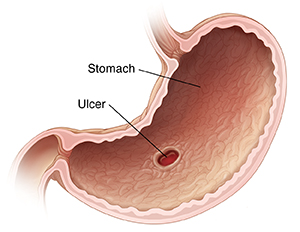Understanding Gastric Ulcers
A gastric ulcer is an open sore in the stomach lining. It's sometimes called a peptic ulcer. This is a more general term for ulcers that may be in the stomach or the upper part of the small intestine. Ulcers can cause pain. But they may also have no symptoms for a long time.

What causes gastric ulcers?
Gastric ulcers have a few common causes. To find the cause of your ulcer, your healthcare provider will give you an exam and take your health history. They may also order some tests. The main causes of gastric ulcers include:
-
Infection with the H. pylori (Helicobacter pylori) bacteria. This damages the stomach lining. Digestive juices can then harm the digestive tract.
-
Long-term use of some over-the-counter pain medicines such as nonsteroidal anti-inflammatory drugs (NSAIDs). These include ibuprofen, naproxen, and aspirin. This reduces the body’s ability to protect the stomach from damage.
Other causes of gastric ulcers include:
Symptoms of a gastric ulcer
Ulcer symptoms may appear and then go away for a time. Symptoms of a gastric ulcer may include:
-
Stomach pain, often a dull or burning feeling toward the top of your belly
-
Feeling full or bloated
-
Heartburn or acid reflux
-
Upset stomach (nausea) or vomiting
-
Vomiting blood
-
Lack of appetite
-
Weight loss
-
Black stool
-
Red blood in the stool
Treatment for a gastric ulcer
Treatment for gastric ulcers may depend on what is causing them. Treatment may include:
-
Not using over-the-counter medicines. You will likely need to stop taking these medicines. But in some cases, these medicines can’t be safely stopped. Check with your healthcare provider to see what is best for you.
-
Taking medicines to ease symptoms. These medicines may help to reduce the amount of acid your stomach makes. They also may help coat your stomach lining.
-
Taking antibiotics. If your ulcer was caused by H. pylori, your provider will likely prescribe antibiotics to get rid of the infection.
-
Having an endoscopy. This is often done to check the stomach and diagnose the ulcer. In some cases, it can also treat the ulcer. It involves passing a flexible tube through your mouth into your stomach and small intestine.
-
Using a tube (catheter) to stop the bleeding. A thin tube is passed into one of your blood vessels. Special tools are used to help stop the bleeding.
-
Having surgery. You often may need this if the ulcer has caused severe symptoms.
Making some lifestyle changes can reduce ulcer symptoms. It may also prevent more damage to your digestive tract. These changes include:
-
Not taking over-the-counter pain medicines such as NSAIDs. Talk with your provider about using another type of pain reliever.
-
Not taking aspirin unless your provider has advised it
-
Limiting the amount of alcohol you drink
-
Quitting smoking
Possible complications of a gastric ulcer
Gastric ulcers can have serious complications. These can include:
-
Bleeding into the stomach
-
A hole (perforation) in the stomach
-
A blockage that interferes with food moving from your stomach to the small intestine
An ongoing infection with H. pylori may be a risk factor for stomach cancer. This is one reason it's important to get rid of these bacteria.
When to call your healthcare provider
Call your healthcare provider right away if you have any of these:
-
Vomiting blood, or vomit that looks like coffee grounds
-
Bloody, black, or tarry-looking stools
-
Fever of 100.4°F (38°C) or higher, or as directed by your provider
-
Chills
-
Pain that gets worse
-
Symptoms that don’t get better with treatment, or symptoms that get worse
-
New symptoms
Online Medical Reviewer:
Jen Lehrer MD
Online Medical Reviewer:
L Renee Watson MSN RN
Online Medical Reviewer:
Rita Sather RN
Date Last Reviewed:
5/1/2022
© 2000-2025 The StayWell Company, LLC. All rights reserved. This information is not intended as a substitute for professional medical care. Always follow your healthcare professional's instructions.